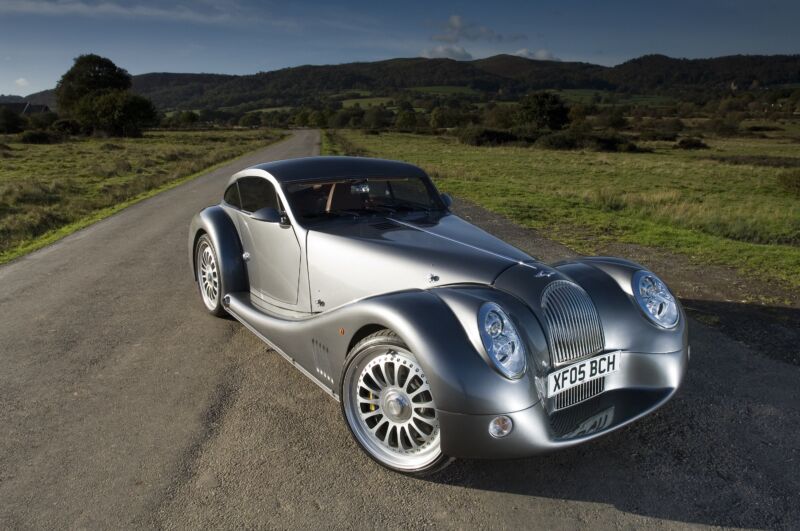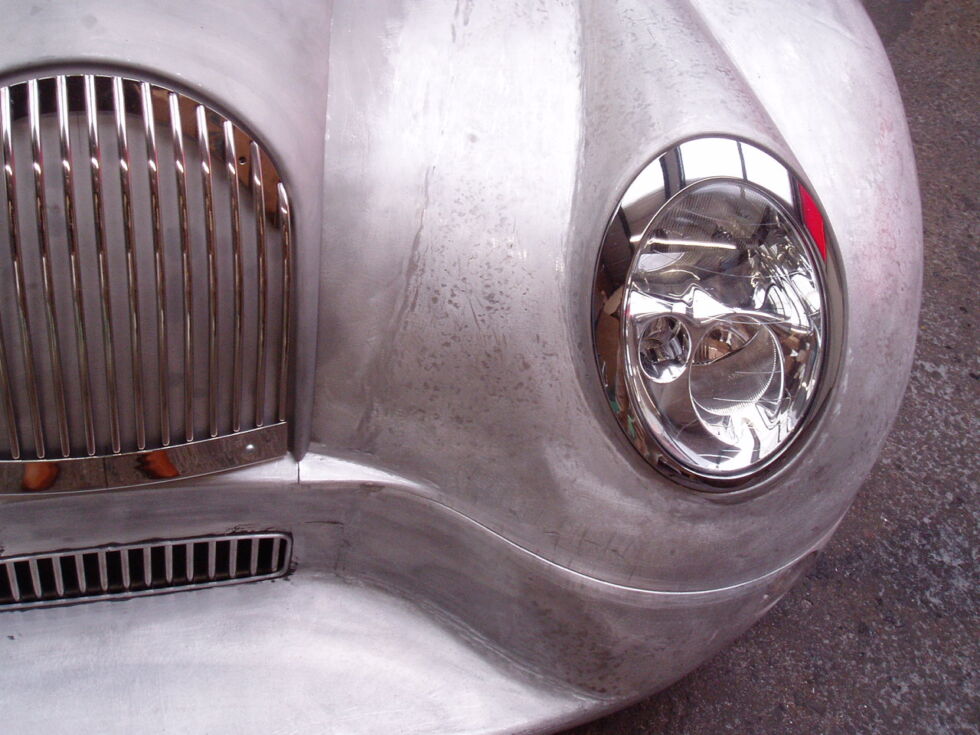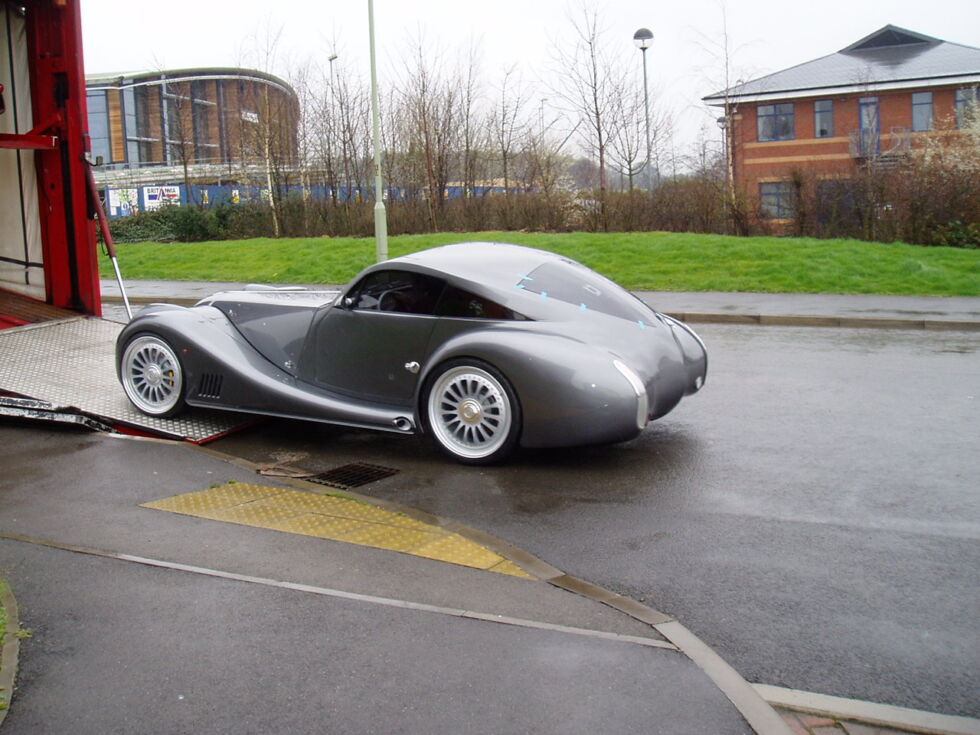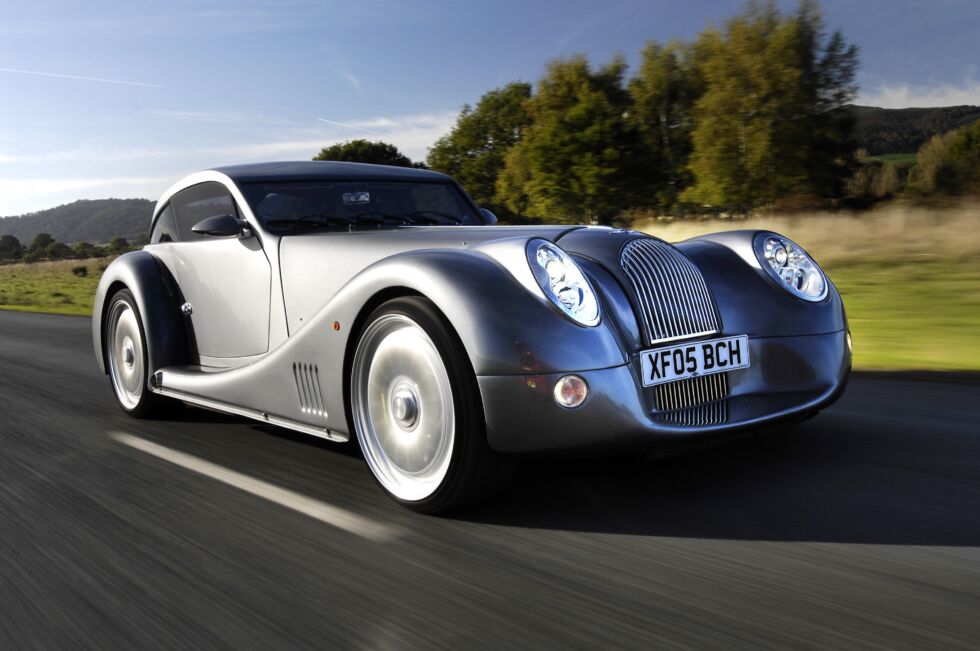Morgan is still best known for making throwback roadsters and for still using wood.

The Morgan Motor Company has been making new cars that look like old cars since its inception over 100 years ago (of course, its cars looked modern when the company started, but you get my gist). The company has always looked to give buyers a blast of old-school British sporting eccentricity, a different kind of proposition than you’ll find with cars that come with engines that sit behind the driver.
Way back in the noughties, though, the company took a crack at doing something modern with the Aero 8. The initial car was interesting to look at, but it came with a V8 and made fun noises. Its distinctive look wasn’t a surprise, as current Head of Design Jon Wells succinctly summed up for me. “There wasn’t a designer [at Morgan],” he said. When Henry Morgan started making three-wheel runabouts in the 1900s, he wasn’t a designer, just “an industrious fellow.” From there, the company was a family business that built cars that all looked the same. Once the vehicles were in the standard shape, all the engineers needed to do was make sure new versions were up to standard.
Twenty-first-century customers—even ones looking for a Morgan—expect more in the way of ergonomics and practicality, and that has led the company to hire actual designers who are able to whip up a vision of past, present, and future at the drop of a hat. But there wasn’t a single one until a guy named Matthew Humphries sent the company a letter in 2004. Humphries was a student at Coventry University’s world-renowned automotive design course at the time, and, much like any designer, he wanted to make his mark on the world.
Part of his degree meant he’d need a placement to get some real-world experience, and after being knocked back elsewhere, he sent Charles Morgan his work. “I’d sent my folio to Charles after being rejected from BMW and [other] places, and he liked it and said, ‘Why don’t you come and work at the factory over the summer?'” Humphries told me.Advertisement
Humphries was installed in an office in the depths of the factory. “At the time, there was no designer at all in Morgan. It was literally Charles [Morgan] taking a Beetle headlamp, sticking it in a wing, and going, ‘Right, go and knock a bit of metal around that,'” Humphries recalled.
- Matthew Humphries’ Aeromax clay model under construction. Matthew Humphries
- The finished Morgan Aeromax clay model, Matthew Humphries

Humphries recalled that there was just one person manning the computer-aided design workstation. The engineering team was tiny, too.
“They put me in a little office above the woodshop, and it was noisy as hell,” he said. “Every time I walked through the woodshop, I used to get wolf-whistled by all the guys because I had a lot of hair.”
Made of stern stuff, Humphries realized that he was right where he needed to be to create some truly special work. “I quickly found out that being there was the best thing because it was one of those places that you see the fantastic skill that the guys had, same as the tin [metalwork] shop,” he said. “Being right in the factory was brilliant because I started to recognize different parts of Morgans that weren’t exposed or visible to the public.”
At the time, Morgan wasn’t a company interested in upsetting the status quo. It made new cars that didn’t look like new cars while competitors raced to create the finest vehicles modern technology could produce. Nothing was broken, so why bother fixing it?
Why bring a designer on-site, then? As it turns out, Charles Morgan had a plan. Classic car collector and Morgan superfan Prince Eric Sturdza was in the market for a hardtop take on the firm’s soft-top-only Aero 8, and Humphries was the man for the job. Few other car companies, even ones as eccentric as Morgan (should they exist), would have given this commission to an intern.
ARS VIDEO
How Scientists Respond to Science Deniers
Having spent so much time in the factory, Humphries saw how the craftsmanship that went into every car could be used as a design feature, and he’d taken inspiration from Figoni et Falaschi, Talbot Lagos, and the Bugatti Atlantic—all from the glory days of fast-flowing, late-1920s design. He set to work, designs were approved, and a clay model was made.
After the clay was finished, Prince Sturdza came to Malvern, made approving noises, and said he’d take it. “‘Oh, great, fantastic. Love it. I’ll have it,’ he said. I thought he meant the clay model. So off I went back to University,” Humphries said.
- Yes, that’s wood being used for the show car—it is still a Morgan, after all. Matthew Humphries
- A huge difference between the Aeromax and the Aero 8 is that the former has a roof. Matthew Humphries
- The finished show car. Matthew Humphries
- For comparison, here’s Peter Morgan posing beside a Morgan Plus 4 in 1984. Daily Express/Hulton Archive/Getty Images

Humphries returned to his studies, assuming that his work was done and that his placement was a huge success—until he got a phone call.
“It was about October 2004,” he said. “I got a phone call from a guy called Dave Kale, who was the tin shop whizz. If you wanted something made in aluminum, Dave was your guy. He said, ‘I’ve got a problem with your clay model.’ They were trying to scale it up.”
If you’ve seen a car designer’s initial sketch or a concept clay, you’ll notice that it’s a bit… differently proportioned. Humphries’ model would have come with a cabin unfit for a human and wheels that would be more suited to a tractor. And what would you expect? Morgan hadn’t “done” a clay model before, let alone a full-scale concept. Humphries was called to work, and so began his strange double life.Advertisement
Not only was his car going to be more than a clay, but the Aeromax (named after Charles Morgan’s son Max) would go on display at the 2005 Geneva Motor Show. Humphries’ life was then split between attending university to become a car designer and going to work on the lowdown to design cars—he couldn’t tell anyone he was working on a new car because it was a company secret.

The next few months were hectic. Various teams had to learn how to actually build the car, the design needed to be tweaked to make it vaguely production-ready, and the company had to find suitable, already homologated parts to make it cost-effective. Contemporary Mini headlights were chosen for the front end, but what about the rear?
“Before we’d formally presented the car to Prince Sturdza, I’d been sketching and thinking about the rear lamps on the Lancia Thesis,” Humphries said. “I rang Charles [Morgan], who said, ‘Oh, I’m in Italy on holiday anyway, I’ll nip down to a dealer and get some.’ I remember him coming back with a set of taillights and a Toblerone from the airport. We ended up building the wing around those lamps because we had them already.”
During this time, Humphries discovered that the development team and the engineers were tough to win over—he was, after all, a student—but the people in the various shops who had wolf-whistled him? That was less tricky. He got, and valued, what they did. “I basically went in and said, ‘We know what you’re doing is really, really skilled. This is fantastic,’ and Nigel on the floor was like, ‘Well, I’ve always done this; it’s just what I do. It’s what my dad did, and my granddad did it. It’s just what we do.’ No, mate—you’re really skilled. This is fantastic work.”

Still, the Morgan team pulled it off, and the Aeromax was at the 2005 Geneva show. Except it wasn’t on open display—it was hidden away, with the original model in the open. “I was 21, and I’d never been to Geneva before, and the Aeromax was in the center on a turntable on the Morgan stand with a wall around it, which made no sense, and the model was outside it,” Humphries said. “One of my tutors from Coventry turned up, and my model was on the outside of the wall. And he said, ‘Oh, isn’t that fantastic! They brought your model!’ I told him to follow me, took him around the wall, and there was the full-size car. I remember his jaw dropping—like, ‘how the fuck has he done this?'”
The finished product went down well—it came with a 4.4 L V8 motor packing 333 hp (248 kW) and 332 lb-ft (450 Nm), and it made an incredible noise. Morgan announced that it would sell 100 of them, and they sold almost immediately. It was a bold step for Morgan, showing that it was more than a company that specialized in Ye Olde Worlde cars.Advertisement
Humphries’ car, essentially a project given to the intern, changed perceptions of Morgan and launched it into a new direction—at least for a time. It was a turning point for the brand, as Jon Wells recalls. “It wasn’t a sort of pastiche—old-looking car on top of a modern platform—it was totally new, refreshing, and respectful of the past as well as embracing the future. So I think it really was a turning point in our history books,” Wells told me.

For those who couldn’t get their hands on one, an Aero Supersports and Coupé were created—taking the Aeromax’s core ingredients and refining them. The classic cars and the futuristic Aero models offered two ends of a scale: one for people who lusted after a Porsche 356 in their youth and another for people who think a modern 911 was too common.
But the new direction and the Aero cars sadly didn’t last, as Humphries recalls. “I left as the push from the board was to stop spending time and money on the future and to concentrate on the traditional cars,” he said. “The final nail was when the Eva GT project was canned. [That car was another ‘future’ Morgan, this time named after Charles Morgan’s daughter.] At that point, I knew I’d had a great time, but it was time to move on to new things.” Humphries hasn’t vanished into the ether, though—he has since lectured at the Royal College of Art, worked as a freelance designer, created his own range of watches, and founded his design consultancy, called MHD.
With Humphries’ departure, the “new,” modern Morgan seemed to be done. Until recently, that is. The Super 3 is a nod to the jet age, and Morgan is promising plenty of new projects—including a collaboration with legendary design house Pininfarina.
Perhaps we’ll see more Aero cars in the years to come?




